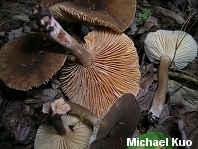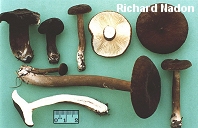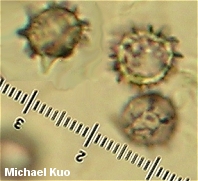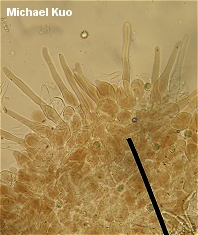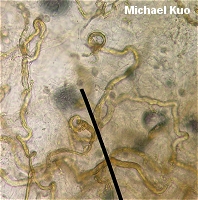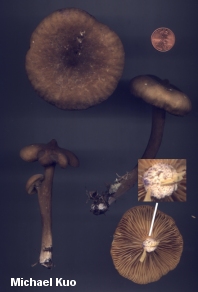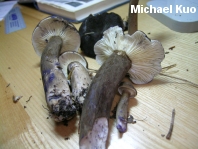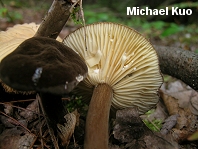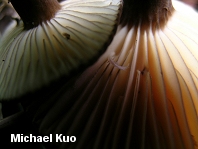| Major Groups > Gilled Mushrooms > Pale-Spored > Lactarius > Lactarius lignyotus |

|
Lactarius lignyotus [ Agaricomycetes > Russulales > Russulaceae > Lactarius . . . ] by Michael Kuo This dark brown, velvety Lactarius grows under conifers in eastern North America and features fairly well-spaced gills, a long stem that is nearly as dark as the cap, and white milk that usually stains the flesh and the gills pinkish. Under the microscope, Lactarius lignyotus has spiny spores that are partially reticulate, and a striking epithelium-like pileipellis. Elias Fries first described Lactarius lignyotus from Sweden in 1855, and the European concept of the species has remained fairly stable for over 150 years--perhaps because the European versions of Lactarius lignyotus do not demonstrate the substantial variability in features manifested in North American versions (the contemporary European account of Lactarius lignyotus can be found in Heilmann-Clausen and collaborators, 1998). In North America, however, we have a big mess on our hands when it comes to lignyotus-like mushrooms, and the species complex is begging for a thorough contemporary investigation based on analysis of carefully documented collections from many locations. Precise determination of ecology is likely to be important, since North American versions of Lactarius lignyotus appear to be associated with diverse conifers (as opposed to the spruce-limited European species) and, in Mexico, with oaks. The traditional approach to the lignyotus group in North America (see Hesler & Smith, 1979) was based almost solely on analysis of differences in physical features--but a modern approach may find it necessary to put these morphological differences in the context of evidence from DNA and ecology. The "typical" variety of Lactarius lignyotus is described below--adapted somewhat to reflect what I believe is substantial variability in several physical features-- followed by an accounting of some of the morphology-defined varieties and related species in North America. The western version of Lactarius lignyotus is Lactarius fallax; it has close or crowded gills. Description: Ecology: Mycorrhizal with conifers, especially spruces and firs; terrestrial but not infrequently found growing from well rotted wood near the ground; late summer and fall; widely distributed in northeastern North America, west to about Wisconsin (but see the comments below for lignyotus-like mushrooms from the Appalachians and from Mexico). Cap: 2-10 cm; convex with a small point in the middle, becoming flat or shallowly depressed, with the central point remaining or disappearing; dry; finely velvety; often with a rugged or wrinkled surface; nearly black when young, dark brown to brown in age; the margin sometimes becoming ridged. Gills: Attached to the stem or beginning to run down it; close or nearly distant; white or whitish, remaining pale until old age, when pinkish to orangish hues often result from drying milk and spore maturation; occasionally with brownish edges; usually staining slowly reddish to pinkish when damaged but sometimes not staining. Stem: 4-12 cm long; up to 1.5 cm thick; more or less equal; dry; textured and colored like the cap, except for a whitish base; often with small ribs at the apex. Flesh: White; usually changing slowly to pinkish on exposure (especially in the base of the stem)--but the change is sometimes absent, slight, or very, very slow to develop. Milk: White; often drying pinkish; staining white paper brown over time. Odor and Taste: Not distinctive. Chemical Reactions: KOH negative on cap surface. Spore Print: Creamy white to orangish yellow. Microscopic Features: Spores 8-10 µ; globose or broadly elliptical; ornamentation REFERENCES: Fries, 1855. (Saccardo, 1887; Atkinson, 1901; Marshall, 1902; Coker, 1918; Kauffman, 1918; Smith, 1949; Hesler & Smith, 1979; Smith, Smith & Weber, 1979; Phillips, 1991/2005; Lincoff, 1992; Bills, 1998; Heilmann-Clausen et al., 1998; Barron, 1999; Roody, 2003; McNeil, 2006; Miller & Miller, 2006; Kuo & Methven, 2010.) Herb. Kuo 09049401, 08300214, 09040206, 09120505. Varieties and Related Species Variation within the lignyotus group in North America occurs primarily with regard to the stains created by the milk and the color of the gill edges. Microscopic differences in the group do not help much in sorting things out; "Lactarius lignyotellus, L. lignyotus, L. fallax, and the varieties of L. lignyotus are so similar that they cannot be distinguished by microscopic structures" (Bills, 1998). Lactarius lignyotus var. canadensis, described from Michigan (Smith & Hesler, 1962), has "marginate" gills that have brown edges--at least, when the mushroom is young--and stains pink like the typical variety. Hesler and Smith report var. canadensis "on sphagnum under spruce in bogs" in northern North America. Lactarius lignyotus var. nigroviolascens (illustrated), described from New York (Atkinson in Burlingham, 1932), stains "dark violet" rather than pink or reddish, and has gills that are not marginate. Hesler and Smith report it from "cold conifer swamps or forests on humus or on sphagnum" in Maine, Michigan, New Hampshire, and New York. The top illustrated collection was made in a northern Michigan hemlock bog. The bottom collection is also from northern Michigan (also under hemlock); it stained dramatically, even on the outer surfaces. Lactarius lignyotus var. marginatus, described from Michigan (Hesler & Smith, 1979), combines dark violet staining with brown-marginate gills. It is reported by Hesler and Smith from a "bog" in northern Michigan, and from Maine. Lactarius lignyotellus, described from North Carolina (Smith & Hesler, 1962) has brown-marginate gills and does not stain at all. Bills (1998) presents Lactarius lignyotellus as associated with red spruce, Fraser fir, and hemlock in the mountains of North Carolina, Tennessee, Virginia, and West Virginia--and documents occasional weak pinkish staining in the stem base "after several hours." Bills maintains that "L. lignyotellus cannot be clearly delimited from the L. lignyotus complex based on morphological features," but suggests that Lactarius lignyotellus populations "[w]ithin their geographical range . . . are relatively uniform, do not exhibit the range of variation reported for northern populations, and can be recognized as a distinct morphological species." In the absence of DNA data Bills's ecology- and distribution-based suggestion for a definition of Lactarius lignyotellus seems preferable to me--but we are then left without a name for marginate, non-staining collections from outside the Appalachians, like the illustrated "cf. lignyotellus" collections, from hemlock bogs in northern Michigan. And Bills's concept leaves no room for the oak-associated non-staining, marginate lignyotus-like mushroom recorded in Mexico as "Lactarius lignyotellus" by Guevara and collaborators (1987) and by Montoya and collaborators (1990). This site contains no information about the edibility or toxicity of mushrooms. |
Lactarius lignyotus var. nigroviolascens Lactarius cf. lignyotellus © MushroomExpert.Com |
|
Cite this page as: Kuo, M. (2011, March). Lactarius lignyotus. Retrieved from the MushroomExpert.Com Web site: http://www.mushroomexpert.com/lactarius_lignyotus.html |
